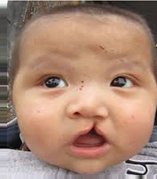Cleft lip and cleft palate, which is known as orofacial cleft. These are facial and oral malformations which occur early in pregnancy, while the baby is still developing inside the mother. Generally Clefting results when there is not enough tissue in the mouth or lip area or when the tissue that is available doesn’t join together properly.
A cleft lip is  a physical split or it is the separation of two sides of upper lip and appears as a narrow gap in the skin of upper lip. This separation often extends beyond the base of the nose and includes the bones of the upper jaw and/or upper gum. Cleft Palate is a split or opening in the roof of the mouth. A cleft palate can involve the hard plate, which means the bony front portion of the roof of the mouth or Soft palate, which means the soft back portion of the roof of the mouth. Cleft clip affects one in 700 babies annually and is fourth most common birth defect in U.S.
a physical split or it is the separation of two sides of upper lip and appears as a narrow gap in the skin of upper lip. This separation often extends beyond the base of the nose and includes the bones of the upper jaw and/or upper gum. Cleft Palate is a split or opening in the roof of the mouth. A cleft palate can involve the hard plate, which means the bony front portion of the roof of the mouth or Soft palate, which means the soft back portion of the roof of the mouth. Cleft clip affects one in 700 babies annually and is fourth most common birth defect in U.S.
Symptoms:
- A split in the lip and roof of the mouth that can affect one or both sides of the face.
- A split in the lip that can appear as only as a small notch in the lip or even extend from the lip through the upper gum, palate into the bottom of nose.
- A split in the roof of the mouth that doesn’t affect the appearance of the face.
Cleft lip and palate can be diagnosed while the baby is still in the womb by ultrasound or canbe removed by surgery during the Childs first year.Finally we can conclude that the mother or father can pass on genes that cause clefting to their children, either alone or as a part of genetic syndrome that includes a cleft lip or cleft palate as one of its signs. In some cases babies inherit a gene that makes them more likely to develop a cleft, and then an environmental trigger actually causes the cleft to occur.
